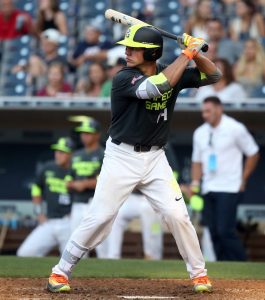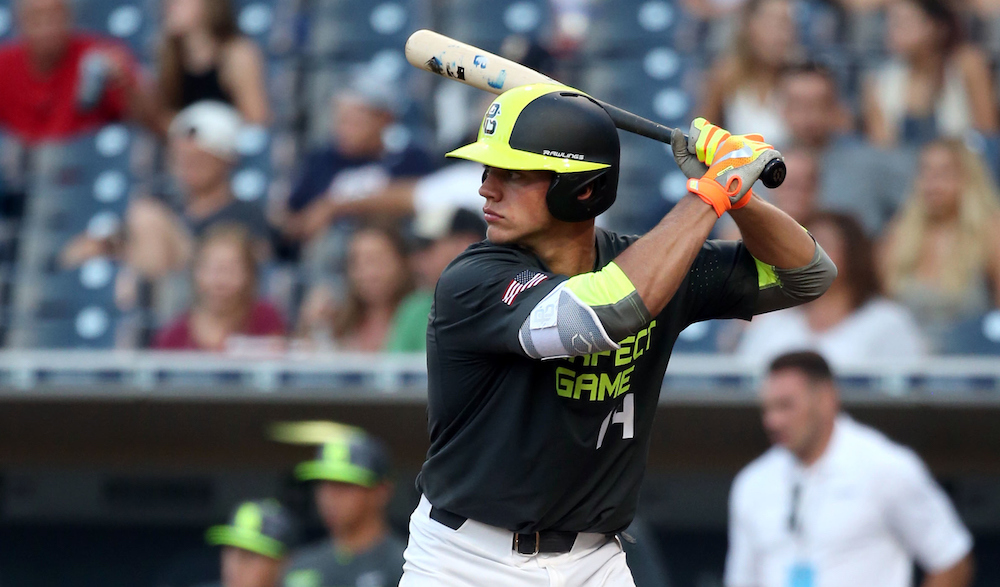Feature Photo: Ben Rortvedt, C, Twins
Editor’s Note: 2080 Baseball is publishing weekly profiles of former Perfect Game All-Americans as they progress through the professional ranks. The series will be published each Wednesday and run through the 2017 Perfect Game National Showcase, to be held June 16-21 in Fort Myers, FL. We’d also like to offer our special appreciation to David Rawnsley, vice president of player personnel for Perfect Game, and Patrick Ebert, PG’s managing editor and scout, for their contributions to the PG in the Pros series. – Mark Shreve

The way that 19-year-old Ben Rortvedt (C, Twins) handles disappointment belies his age. In 2016, the then high school senior was one of the last cuts from the 40-man USA Baseball National Team roster. Instead of feeling sorry for himself, Rortvedt drove immediately to the batting cages in his hometown of Verona, WI, put the headlights of his car on so he could see the pitches as they came out of the machine, and pounded baseballs long into the night to clear his head of the frustration of being cut. A few months later, Rortvedt’s work would pay off when his name was called by the Minnesota Twins as the 56th overall pick in the second round of the 2016 draft, and signed to a $900,000 bonus.
Rortvedt had to build his own path to professional baseball. Verona (population 10,619) has only one high school and had never had a baseball player selected in the MLB Draft before Rortvedt. On his own, Rortvedt worked his way onto scouts’ radar, participating in travel baseball and in showcases, such as Perfect Game USA, to get his talents in front of evaluators.
“I got involved with a pretty good travel baseball team [the Hitters, based in Calendonia, WI] which set me up with some opportunities to get in front of the right people, and I was just lucky enough for them to take notice,” Rortvedt said. “Playing with [the Hitters] got me in front of some scouts, and that opened doors for other things.”
One of those “other things” was being named to the Perfect Game All-American Classic in 2015, which led to many more opportunities for Rortvedt to perform in front of scouts and his profile rose significantly. By draft day, Rortvedt was considered one of the top prep catchers available because of his full plate of tools—a strong arm, power potential, a plus hit tool and reliable defense from behind the dish.
In his small Wisconsin town, Rortvedt stood out from an early age. His former high school coach, Brad D’Orazio, remembers vividly when he first met Rortvedt, then a freshman coming out for the school’s baseball program.
“He was so physically mature as a freshman, so filled out and strong,” D’Orazio said. “Broad shoulders and his hands were huge. I’ve never seen anyone like that.”
D’Orazio, who has been coaching baseball for nearly two decades, did not hesitate to name Rortvedt the most talented player he has ever seen. However, what made Rortvedt special, according to D’Orazio, was his internal drive.
“The thing that sets him apart from anyone else is not just that he is the best player I have ever seen,” D’Orazio said. “If he wasn’t sleeping, he was hitting the gym, hitting off of a tee, or harassing people to throw to him.”

Ben Rortvedt (C, Twins) participating in the 2015 Perfect Game All-American Classic at Petco Park on August 16, 2015 in San Diego, California.
Rortvedt’s dedication extended into his social life, as he eschewed the Friday night lights of high school football to make more time for baseball.
“I don’t think he went to many football games on Friday nights. He was bussing tables to pay for those showcases. He was singularly focused,” D’Orazio said.
Perfect Game vice president of player personnel David Rawnsley echoes these sentiments about Rortvedt’s work ethic and drive to succeed.
“He has always had a friendly rivalry with Cooper Johnson [now playing for the University of Mississippi],” Rawnsley said. “Cooper came to our pitcher/catcher indoor showcase in Iowa in the middle of his junior year. Absolutely kicked ass, one of the best defensive catchers I’ve seen. And Ben saw what I wrote after Cooper was in Iowa. He came three weeks later to a new showcase in St. Louis and said, ‘I’m better than Cooper Johnson, so I’m going to show that.’”
Like the trip to the batting cages after being cut from the USA Baseball squad, Rortvedt hopped in his car and set out to show the world that he was a top talent.
“He drove down to St. Louis from Wisconsin because he wanted to prove himself. He wanted at that age to play against high-level competition,” Rawnsley said.
Rortvedt might not have been the better catcher defensively in that showcase, Rawnsley said, but he offered so much with his bat that it didn’t matter.
“He showed far more power than we thought he had,” Rawnsley said. “He just bombed the ball. A left-handed catcher with plus power, that just adds some intrigue to the evaluation.”
After being drafted by the Twins, Rortvedt split his professional debut season between the Rookie Gulf Coast Twins and the Rookie Elizabethton Twins of the Appalachian League. In 33 games, he hit .222/.306/.253. Despite those numbers, the Twins weren’t afraid to challenge Rortvedt at the start of the 2017 season with an assignment to Class A Cedar Rapids of the Midwest League.
It has been a slow start for Rortvedt offensively with the Kernels. Through May 22, he was batting .153/.210/.194 in 29 games and 105 plate appearances. The sturdily built left-handed hitter isn’t focused on his numbers, however.
“For me, defense comes first, and I just try to be the best defensive catcher I can because defense is going to get you to where you want to be,” Rortvedt said. “I’m just going through ups and downs throughout the season [offensively]. It’s a long year. I haven’t come out swinging the bat as well as I was in spring training, and I just know that we have a lot of games to go, so I’m not even thinking twice about it. I know it’s going to come around.”
Rawnsley offered some insights into why Rortvedt wasn’t hitting yet, attributing much of it to how Rortvedt had to spend his time during spring training.
“The worst thing to do is be is a catcher in spring training because you have to catch all those bullpens,” Rawnsley said. “Everyone else is taking BP, but you’re catching bullpens. You get very few reps in spring training. Being a 19-year-old catcher in spring training is like the ultimate thankless job in baseball. You catch every bullpen; you never take off your shin guards. By the time he gets a bat in his hands, he has been here 17 hours, he’s exhausted.”
Rortvedt is hardly one to complain, however, and he is accustomed to working hard for what he’s after. He knows that the level of pitching that he is seeing is making it difficult for him to string hits together, but Rortvedt remains confident in himself.
“I came out of high school and I could hit, but the pitching has increased, so my hit factor hasn’t been as high as it was, but I’m chipping away at it,” Rortvedt said.
Rortvedt has named defense as his top priority for the 2017 season. He stressed the importance of relationship building and strong rapport with his pitching staff at Cedar Rapids.
“Having them trust you as much as they can and having them like to throw to you is important to me,” Rortvedt said. “I want to be a well-rounded catcher, so I want them coming up to me to catch their bullpens. I want to put in the work with them and gain their trust.”
Rawnsley noted that Rortvedt’s strength, size, lateral quickness, and arm strength matched up with his surprising power to give him all the necessary tools to one day become an everyday big league catcher.
Rortvedt is likely to spend the entirety of 2017 in the Midwest League, where he will accumulate at-bats against Class A pitchers that are, on average, two years his senior. This season is the first major step in Rortvedt’s journey up the Twins’ organizational ladder, but, as his time in high school proves, he is used to the climb.


